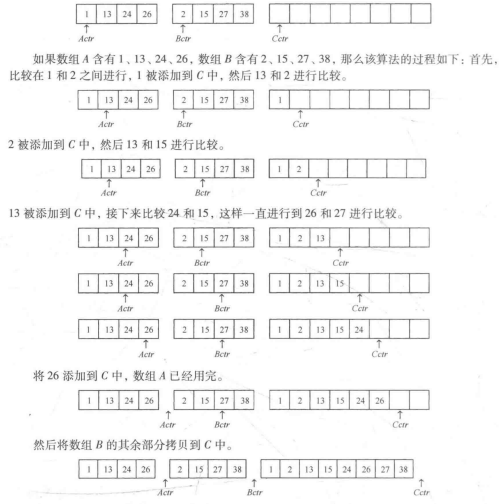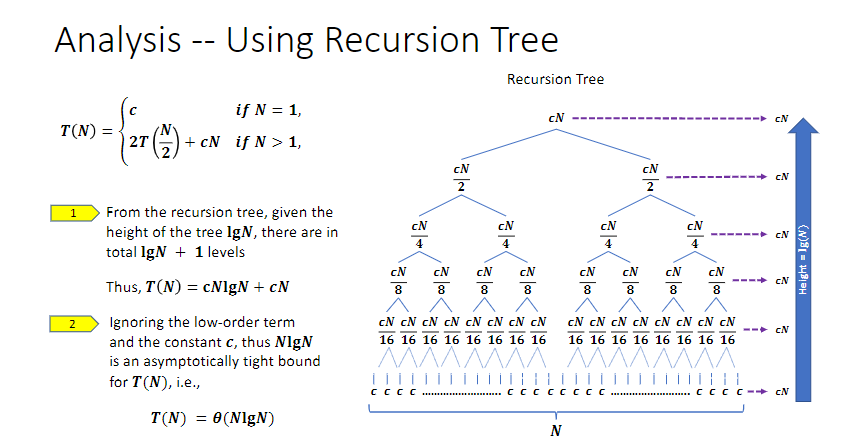排序算法 归并排序 归并排序是一种高效的基于比较的分治递归算法
Merge sort runs in 𝑶 𝑵𝐥𝐠𝑵 both worst-case and average-case running time and the number of comparisons used by the algorithm is nearly optimal.
归并排序的许多实现是稳定的,即输入和输出中相等元素的顺序是相同的
归并排序:将待排序的元素序列分成两个子序列,每个子序列有N/2个元素
分而治之 归并排序算法遵循分而治之的范式,将问题划分为多个子问题,这些子问题是同一问题的较小实例
归并排序:对两个子序列进行递归排序,合并两个排序的子序列以产生排序的答案
1.Divide the problem into a number of subproblems that are smaller instances of the same problem
图解 在这个图解中,假设了A、B均是非递减数组,实质上在我们后面利用递归计算的时候,不用考虑传入数组的性质的
说白了,归并的核心步骤在于“从A/B数组中找到较小值并加入于C中”
实现:书本实现 先谈谈书本的实现,个人认为更好理解而且适用性更高
1 2 3 4 5 6 7 8 9 10 11 12 13 14 15 16 17 18 19 20 21 22 23 24 25 26 27 28 29 30 31 32 33 34 35 36 37 38 39 40 41 42 43 44 45 46 47 48 49 50 51 52 53 54 55 56 57 58 59 60 61 62 63 64 65 66 67 68 69 public static void mergeSort (AnyType [] a) { AnyType[] tmpArray = (AnyType[]) new Comparable [a.length] ; mergeSort(a,tempArray,0 ,a.length-1 ); } private static void mergeSort (AnyType [] a , AnyType[] tempArray , int left , int right) { if (left < right){ int center = (left + right) / 2 ; mergeSort(a,tempArray,left,center) ; mergeSort(a,tempArray,center+1 ,right) ; merge(a,tempArray,left,center+1 ,right) ; } } private static void merge (AnyType[] a , AnyType[] tempArray , int left , int rightPoint , int rightEnd) { int leftEnd = rightPoint - 1 ; int temPos = left ; int numElements = rightEnd - left + 1 ; while (left <= leftEnd && rightPoint <= rightEnd ){ if (a[left].compareTo(a[rightPoint]) <= 0 ){ tempArray[temPos++] = a[left++]; }else { tempArray[temPos++] = a[rightPoint++] ; } } while (left<=leftEnd){ tempArray[temPos++] = a[left++] ; } while (rightPoint <= rightEnd){ tempArray[temPos++] = a[rightPoint++] ; } for (int i = 0 ; i < numElements ; i++){ a[rightEnd] = tempArray[rightEnd] ; } }
实现:百度百科 这部分实现来自百度百科,几乎没有注释,仅仅作为补充
1 2 3 4 5 6 7 8 9 10 11 12 13 14 15 16 17 18 19 20 21 22 23 24 25 26 27 28 29 30 31 32 33 34 mergeSort(data,left,right){ if (left<right){ center = (left+right)/2 mergeSort(data,left,center); mergeSort(data,center+1 ,right) ; merger(data,left,center,right) ; } } merge(data, left, centre, right) n1= centre – left + 1 n2= right - centre let L[ 0. .n1] and R[ 0. . n2] be new arrays for 𝑖= 0 to n1 L[ 𝑖] = data[ left + 𝑖] for j = 0 ton 2 R[ 𝑗] = data[ centre + 𝑗] L[ n1] = R[ n2] = ∞ 𝑖= 𝑗= 0 for 𝑘= left toright if L[ 𝑖] ≤R[ 𝑗] data[ 𝑘] = L[ 𝑖++ ] else data[ 𝑘] = R[ j++ ]
实现——完全代码:百度百科 1 2 3 4 5 6 7 8 9 10 11 12 13 14 15 16 17 18 19 20 21 22 23 24 25 26 27 28 29 30 31 32 33 34 35 36 37 38 39 40 41 42 43 44 45 46 47 48 49 50 51 52 53 54 55 56 57 58 59 public class MergeSort { public static void main (String []args) { int [] arr = {9 ,8 ,7 ,6 ,5 ,4 ,3 ,2 ,1 }; mergeSort(arr); System.out.println(Array.toString(arr)); } public static void mergeSort (int []arr) { int []temp = new int [arr.lengrh] ; mergeSort(arr,0 ,arr.length-1 ,temp) ; } public static void mergeSort (int []arr,int left , int right , int []temp) { if (left<right){ mergeSort(arr,left,mid,temp) ; mergeSort(arr,mid+1 ,right,temp) ; merge(arr,left,mid,right,temp) ; } } private static void merge (int [] arr , int left , int mid , int right , int [] temp) { int i = left ; int j = right ; int t = 0 ; while (i<=mid && j<=right){ if (arr[i] <= j<=right){ temp[t++] = arr[i++] ; }else { temp[t++] = arr[j++] ; } } while (i<=mid){ temp[t++] = arr[i++]; } while (j<=right){ temp[t++] = arr[j++]; } while (left <= right){ arr[left++] = temp[t++]; } } }
归并排序的算法分析 结论:𝑻(𝑵) = 𝜽(𝑵𝐥𝐠𝑵)
见前文,我们知道了“合并两个已排序的表的时间是线性的” ,舍合并为N一次归并排序的完成时间 为T(N),其中T(1) = 1归并排序 = 左侧归并+右侧归并+合并 ,显然左右的大小可以视作相等,于是可得:
另外,还有一种方式推出公式,于书P197页,这里不再赘述
最后附上MIEC CS211课间中的推导图,和本文的方式是完全一样的:











